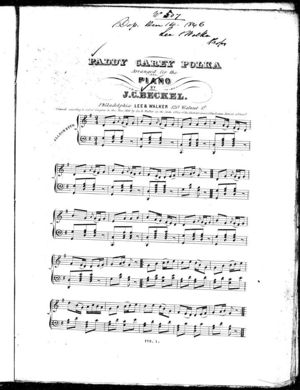Annotation:Paddy Carey (2)
X:1 T:Paddy Carey [2] M:6/8 L:1/8 R:Jig Q:"Lively" B:Sutherland - Edinburgh Repository of Music (p. 26) Z:AK/Fiddler's Companion K:C G2c cBc|e2c cBc|A2d d2e|f2d {c}B2G| G2c cBc|e2c cBc|BAG GAB|c3 c3:| |:c2e f2a|g2a gec|c2e f2a|gec d3| c2e f2a|g2a gec|cBA GAB|(c3 c3):|]
PADDY CAREY [2] (Paidin Ua Ciarda). AKA - "Paddy Carrey," "Paddy Keary." AKA and see "Paddy Carrey's Fortune." Irish, English, Scottish; Air and Country Dance Tune (6/8 time) or Jig. England; Shropshire, Lancashire. C Major (Clinton, Hamilton, Haverty, Robbins, Sutherland): D Major (Ashman, Clinton, Kennedy, Kerr, O’Neill, Ross): G Major (Sumner). Standard tuning (fiddle). AB (Haverty): ABB (Clinton): AABB (Ashman, Robbins): AABBCC (Hamilton, Kennedy, O'Neill, Ross): AABBCCDD (Kerr, Doyle, Sumner). “Paddy Carey” or “Paddy Carey’s Fortune” was a song composed for the theatre in the late 18th century and popular for the next 100 years. It still has cachet as a dance tune. The The Lester Levy Sheet Music Collection has an undated set of the song, published by C. Taws, Philadelphia, entitled "Paddy Carey's Fortune or Irish Promotion, A favourite Comic Song." Words in that publication are credited to a “Mr. Cherry,” with music by “J. Whitaker.” The Mr. Cherry probably refers to and Irish actor named Andrew Cherry, who was popular on the London stage of the late 18th-early 19th centuries. Cherry was also a playwright and penned the words to the song “Bay of Biscay.” The melody entered tradition early: a version is contained in the 1780 music manuscript of Scottish musician John Fife (a microfilm copy of which is in the National Library of Canada). A broadside version of the ballad begins:

‘Twas at the town of neat Clogheen,
That Sergeant Snap met Paddy Carey;
A cleaner boy was never seen,
Brisk as a bee, light as a fairy.
His brawny shoulders four foot square,
His cheeks like thumping red potatoes;
His legs would make a chairman stare,
And Pat was love by all the ladies:
Old and young, grave and sad,
Deaf and dumb, dull and mad,
Waddling, twadling, limping, squinting,
Light, brisk and airy.
The tune is sometimes paired in a medley with “Morgan Rattler” in southern England sessions. One of the oddest appearances of the tune is on the barrel organ from the polar expedition of Admiral Parry of 1819. In place of a ship’s fiddler (common in those days), Parry introduced a barrel organ on board ship to provide entertainment and a vehicle to which the men could exercise (i.e. by dancing). “Paddy Carey” was one of eight tunes on barrel no. 5, unidentified on the recording.
“Paddy Carey” appears in a startling number of British musician’s 19th century manuscript collections, including those of the Welch family (Bosham, Sussex), Rev. Robert Harrison (Brampton, Cumbria, 1820), H.S.J. Jackson (Wyresdale, Lancashire, 1823), John Clare (Helpston, Northants, c. 1820), James Winder (Wyresdale, Lancashire, 1835), William Tildesley (Swinton, Lancashire, c. 1860), John Moore (Ironbridge, Shropshire, 1820), William Clarke (Feltwell, Norfolk, 1858), Joshua Gibbons (Market Rasen, Lincolnshire, 1820), Richard Pyle (Nether Wallop, Hants, 1822), an anonymous ms. from the west Midlands, the Durham ms, the Tiller ms, Ellis Knowles (Radcliffe, Lancashire, c. 1847), and a manuscript in the Vaughn Williams Memorial Library of EFDSS known as MS 36 (all per Barry Callaghan, 2007). It was entered in the mid-19th century music manuscript of William Winter, a shoemaker and violin player who lived in West Bagborough in Somerset, southwest England. The jig proved popular among American musicians as well, appearing in the music copybooks of H. Canfield (Hartford, Conn., 1823), Daniel Henry Huntington (Onondaga, N.Y.), a commonplace book labelled “Greenfields” of. c. 1811, and M.E. Eames' 1859 copybook (p. 79). In America it was also printed on song sheets and in music tutors, and in Riley’s Flute Melodies, vol. 2 (New York, 1817).

